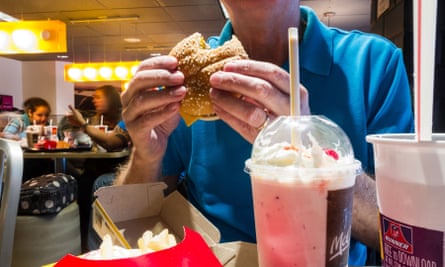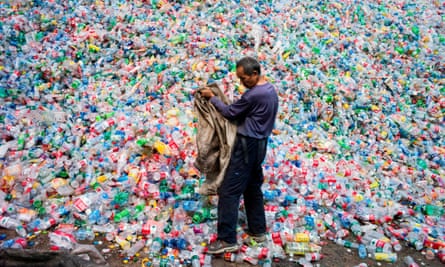Europe is beating its addiction to plastics. Why is the US so far behind?
Though I grew up in the United States, I’ve spent the majority of my adult life in France – which means that every trip “back” across the Atlantic has become a moment of curiosity and culture shock. Most recently, the shock was over the sheer prevalence of plastics in American daily life.
In Paris, and elsewhere in Europe, plastics are clearly on their way out and paper is in. The standard takeaway cup in coffee shops, juice bars and cafes serving hipster smoothies is paper, and when there is a straw, it’s paper as well (or some other biodegradable non-plastic material). Delivery food orders arrive in paper cartons –some with a chic design touch that plastic could never replicate, unspooling like origami flowers to reveal the food within – in paper bags. Utensils, when requested, are wooden and wrapped in paper. And in grocery stores, bulk sections for pasta, nuts, dried fruit, cereals, rice and legumes are normal, as is putting those things (or your fruit and vegetables) in paper bags.
Fast food chains such as Pret A Manger, which has opened in at least six European countries outside the UK, Exki, which has branches throughout the Benelux countries and France, and even McDonald’s and Burger King serve food consumed on location in glass or other types of reusable packaging. Extended producer responsibility schemes (which hold companies to account for recapturing the packaging they produce) mean that plastic bottle caps no longer fully detach, increasing the likelihood that they too end up recycled.
Setting foot in the US, on the other hand, felt like stepping out of a time machine – and not in the right direction. Even in progressive spaces, plastics reigned supreme. At a coffee shop in New York City’s East Village with an LGBTQ+ flag, gender-inclusive bathrooms and Black Lives Matter signs, my iced coffee came in a plastic cup with a plastic straw. In Cleveland, where my parents live, the same story: plastic containers, plastic-wrapped plastic utensils, plastic cups, plastic straws in their plastic packages, and in grocery stores, plastic bags for produce, which were then automatically double-bagged in plastic at checkout counters.

Is it the transatlantic difference in ecological awareness or the pull of different cultural norms? After all, the US is the country that pioneered the disposable, fast-food society in the 1950s, and then exported it elsewhere. France leaned heavily into fast food (in fact, it has one of the world’s highest numbers of McDonald’s per capita) but shows that a society converted to single-use “convenience” can adjust when political and legislative change demands it.
Too much focus on virtuous individual behaviour is clearly misplaced. It distracts from industry and lets polluting corporations and governments outsource responsibility for systemic change at scale. And systemic change at scale is exactly what the EU’s 2021 ban on single-use plastics is in the process of achieving, by intervening at the producer level in a way that has had a visible domestic – and international – effect.
Back in Europe, the message was hammered home by an visit to Lisbon’s Museum of Art, Architecture and Technology (MAAT), which recently hosted an exhibition on plastics. “The industry was quite shaken up by the EU directive on plastics,” says Anniina Koivu, a materials and design professor at Lausanne’s Ecal and the curator of Plastic: Remaking Our World. She told me that the legislation has accelerated interest from companies in design alternatives to plastics, and in funding available for scaling promising prototypes – such as one student’s redesign of medical garments and another student’s fully biodegradable nappy design.

In part, that’s because the EU directive included criteria for ecological packaging designs and EPR requirements, along with its more visible component: a ban on single-use items such as cigarette butts, straws, bottle caps, cutlery, wet wipes, food containers and some types of fishing gear.
An EU impact assessment of the directive found that a ban on some items coupled with increased EPR regulations, changes in product design and incentives for fishers to return used items could reduce single-use plastic waste in the marine environment by 50%. Another result is that plastic waste recycling capacity in the EU has increased by over 13%, which is particularly crucial after China, previously a key destination for global waste products, stopped taking recyclables from abroad in 2017. (In Europe, 30% of plastic waste is recycled, while in China the figure is about 17% and in the US just 5%.)
after newsletter promotion
Global environmental focus is – rightly – on carbon emissions, but the crisis is dual and interlinked, involving both climate change and biodiversity loss. Sometimes the emissions calculations (what emits more CO2, plastics or their alternatives?) can be complex and even irresolvable. But plastics are intensely destructive to biodiversity – particularly to fragile marine ecosystems that are already under pressure from rising temperatures.
This is a worldwide issue, not just a European one: Asia produces just over half of the world’s plastics and is at the centre of marine plastic pollution. But in addressing its own contribution to the problem, the EU can use its market power to exert a mix of coercion and influence on global companies and its trading partners. For example, despite Brexit, next month England is extending its single-use plastics ban. Perhaps even in the US, throwaway culture can be chucked in the recycling bin for good.
Alexander Hurst is a France-based writer and an adjunct lecturer at Sciences Po, the Paris Institute of Political Studies